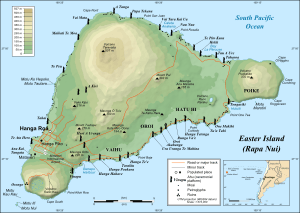Rano Kau facts for kids

Rano Kau is a huge, inactive volcano on Easter Island. This island is part of Chile and is located far out in the Pacific Ocean. Rano Kau is 324 m (1,063 ft) tall and forms the southwestern tip of the island. It was created by lava flows a very long time ago, between 150,000 and 210,000 years ago!
The Volcano's Crater
Rano Kau has a large lake inside its crater. This crater lake is one of only three natural sources of fresh water on Easter Island. The lake sits about 100 metres (330 ft) above sea level. However, it is more than 200 metres (660 ft) below the highest edges of the crater.
Most of the volcano is surrounded by the ocean. Over time, the sea has worn away parts of the volcano, creating tall sea cliffs. At one spot, called te kari kari, the ocean has even started to cut into the crater wall itself. The inside walls of the crater are quite steep, sloping at angles between 65° (very steep near the top) and 45° (gentler near the lake). From the ancient village of Orongo, the cliff drops sharply at a 50° angle down to the sea, about 300 metres (980 ft) below. On its northern side, the volcano slopes down towards Mataveri International Airport.
Rano Kau is part of the Rapa Nui National Park, which is a World Heritage Site. The park is divided into seven areas, and Rano Kau is one of them. The most important old site on Rano Kau is the ruined ceremonial village of Orongo. This village is located where the sea cliff meets the inner crater wall. In the 1880s, people saw an ahu (a stone platform) with several moai (large stone statues) on the cliffs of Rano Kau. But by 1914, when the Routledge expedition visited, these statues had fallen to the beach below.
Besides the common rock basalt, Rano Kau also has other interesting rocks like obsidian and pumice. Obsidian was very important because it was a main source for the island's ancient stoneworkers to make tools.
The crater is almost a mile wide and has its own special weather. It is protected from the strong winds that blow across most of the island. Because of this, plants like figs and vines grow well inside Rano Kau. The inner slope of the crater was once home to the very last wild toromiro tree. Sadly, this tree was cut down for firewood in 1960.

See also
 In Spanish: Rano Kau para niños
In Spanish: Rano Kau para niños
- List of volcanoes in Chile
- Sirolimus


